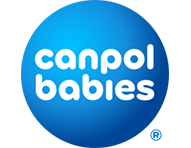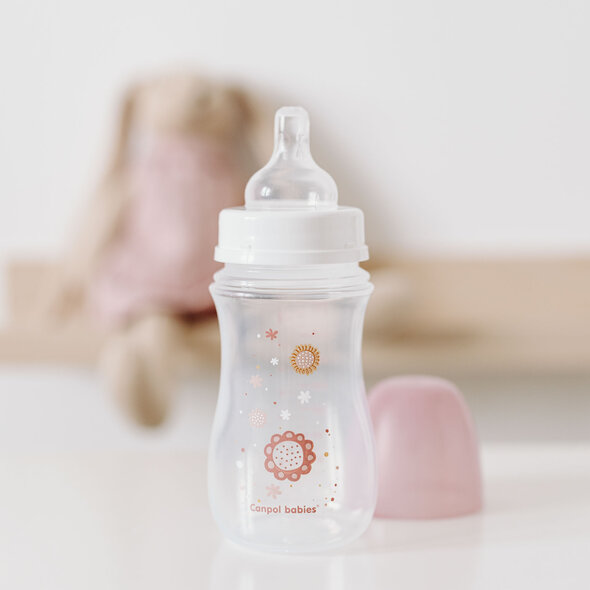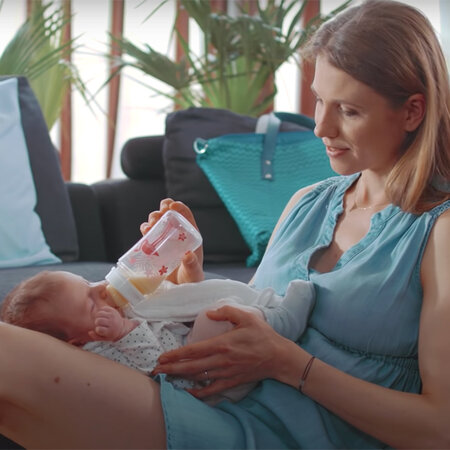

Are you breastfeed and would like also to give milk from the bottle? Check what positions will be safe for your baby while bottle feeding!
Polish Society of Pediatric Gastroenterology, Hepatology and Nutrition recommends only breastfeed your baby for the first six months of life. Breastfeeding has many benefits for both mother and baby. However, not every woman is able or willing to breastfeed. Some women breastfeed with expressed milk by using a breast pump and give the milk only in an alternative way. There are also mothers who prefer to combine breastfeeding and bottle feeding. In such situations, a bottle for newborns and infants will be helpful. It is exceptionally important to feed the baby from the bottle in a safe position. Thanks to this, the baby will be calm when suckling food from the bottle and will not choke.
Breastfeeding and bottle feeding position is important primarily because it provides the baby with comfort and safety. However, it should not expose it to aspiration or choking or increase the occurrence of colic. Lack of comfort when feeding with a baby bottle may make the baby reluctant to eat from the bottle, which will not only make the feeding process more difficult, but also prolong it. Too shallow and leaky gripping of the base of the teat (as well as the nipple and areola) may cause swallowing of air while suckling, which may result in colic and tummy problems. As a result, bottle suckling (as well as breastfeeding) may be ineffective and the child will gain weight incorrectly (too little).
Safe position for bottle feeding is one in which the baby's head is higher than its body and the bottle is placed in the baby's mouth at an angle. It is important to observe the baby - if milk is leaking from the mouth or the baby is struggling to breathe regularly, it is a sign that something needs to be changed. Perhaps it's a matter of the position in which you feed.
Remember: regardless of the position, the bottle should be held at an angle so that the milk fills the teat.
This position is the most commonly used and the closest to the classic breastfeeding position. Sit comfortably in an armchair or on the sofa. Take the baby in your arms, rest the baby's bottom against one thigh and the back against the other, raised slightly upwards, so that the baby can be fed in a semi-reclined position. The head should be resting on the crook of your elbow or supported by your hand.

An example of a safe position is to place the baby facing away from you. Sit on the floor with your back against a wall or pillow, bend your knees and place your baby so that his legs are near your breasts, its buttocks are in the crease between baby’s belly and legs, and its back is against your legs.
Another safe position is to feed a baby from the bottle in a sitting position, but with the baby lying sideway. The side position is recommended for babies who suffer from reflux or frequently burp while feeding. Sit on the floor with support under your back, position your legs so that they are bent at the knees. Place the baby sideways on one thigh, and rest your back and head on the other thigh. Rest your baby's down part of the body against your belly.
The side position is recommended for babies who often posseting while feeding. Mom sits on the floor with support under her back, her legs bent at the knees. The baby is placed sideways on one thigh, with its back and head resting on the other thigh. The butt rests on the belly.
After eating, a small child should burp, i.e. release the air from the stomach that was swallowed during feeding. This is a completely natural phenomenon and occurs in most newborns. There is no contraindication for a baby to burp during a meal, because burping does not necessarily mean the end of feeding. Does every child burp? No, although it occurs in most children. It is also worth noting that burping occurs more often during the day than at night, because a sleepy baby eats less greedily and swallows less air.
Why is it so important for a baby to burp? Thanks to this, we will reduce the likelihood of spilling the eaten food and the occurrence of colic in the baby and abdominal pain caused by accumulated gases. Burping after giving a bottle to a newborn is particularly important, but burping is also important for children during infancy. With time and the development of the digestive system, the baby will stop burping after a meal.
The most popular burping position is to place the baby on your shoulder. Rest your baby so that its head is on your shoulder, baby’s arms are on your back, and its legs are slightly bent. Support the baby's bottom with one hand and the baby's back with the other. You can pat your baby's back. Placing the baby in this position causes gentle pressure on his chest and releases the accumulated air.
The most important mistake you can make when feeding your baby with a bottle is feeding it lying down. In young children, food often flows back into the esophagus. A situation in which a baby lies flat on its back is dangerous because the baby may choke or choke during feeding.
It is also dangerous to leave a baby alone with a bottle. Regardless of whether the baby is in a bed, on the couch, in a rocking chair or elsewhere, he cannot be left without adult supervision. In the event of choking or aspiration, we are unable to react quickly, which puts the child at risk.
Consultation: Katarzyna Orawiec-Rymszewicz
midwife and lactation educator